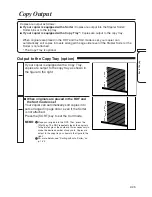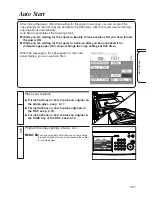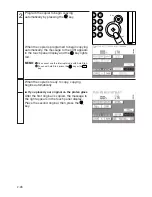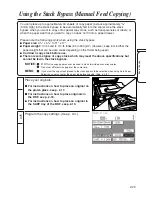
2-16
Original Placement
There are three methods for placing originals for copying. The original placement method
that you select depends on the size and type of originals you are using, and the copy
settings you have programmed.
■
Platen glass
Use when copying books, originals on heavy paper, lightweight paper, and
transparencies, etc.
■
RDF (Recirculating Document Feeder)
Place a stack of originals in the RDF, and they are automatically fed to the platen glass for
copying. The RDF can also turn over two-sided originals to make two-sided copies.
■
SADF (Semi-Automatic Document Feeder) tray
Use when copying a heavy or lightweight original.
Orientation of Originals
[RDF/SADF tray]
[Platen glass]
You can place originals vertically or horizontally. Always align the top edge of your original with
the back edge of the platen.
NOTICE:
●
LTR and STMT-size originals can be placed vertically or horizontally. However, the copy
speed for vertically placed paper is somewhat faster than that for horizontally placed paper.
Place originals horizontally when using preset copy ratios to convert one standard paper size
to another (e.g. when converting an LTR-size original to an 11" x 17"-size copy).
(“LTRR” and “STMTR”-sizes refer to horizontally placed LTR and STMT-size paper.)
●
11" x 17"-size originals must be placed horizontally.
●
STMT-size originals must be placed vertically in the RDF.
●
Be certain to place the original horizontally when copying LTRR, STMTR and other horizontal
sizes. If the original is placed vertically, the back of the copy will be copied upside down.
ABC
V
Horizontal placement
Horizontal placement
V
ABC
Vertical placement
Vertical placement







































